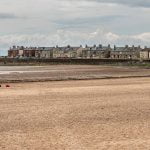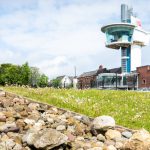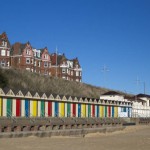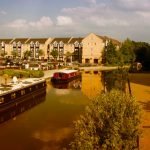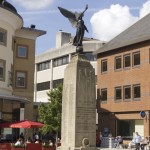Famously built to keep out the Viking invaders, Runcorn is a thriving seaside staycation destination.
Runcorn is one of those towns which has everything. It is a bit of a tourist attraction, given its location inside Cheshire. It was a designated New Town in 1964, meaning it saw super expansion, it is an industrial town and a port town. About 61k people call this town home, many of them descended from shipwrights. Let’s investigate the beautiful, brilliant, and very British streets of Runcorn.
What is Runcorn Famous For?
Rumours prevail that Runcorn was a Viking town. It was an anti-Viking town really. The town is most famous for the Runcorn Gap and for being a cargo port on the south banks of the River Mersey. The Bridgewater Canal brought industry here during the Industrial Era, and it hasn’t stopped growing since.
The Early History of Runcorn
The Vikings knew Runcorn as Rumcofa, even though it was not built for them. An interesting thing happened between the Danes and the Anglo-Saxons back then. During the birth of England, there were four main kingdoms in England. There was Mercia, Wessex, East Anglia, and Northumbria. Where Northumbria joined last, the other three kingdoms made the foundation of what would be England under Alfred the Great. Between this period and the full immersion of the Danes, there was a period known as Danelaw, where Angles, Saxons, Roman descendants, English tribe descendants, and Danes all lived in peace, under this law.
Now just before the Viking Warlords started declaring themselves kings of Mercia/Wessex/Anglia, there was a turbulent time when each of the kings of these kingdoms had to build fortresses on the edge of their land to mark the boundaries. Why they used fortresses and not fences come down to the Vikings. They would land in one area, set up farmland, and then spend their free time raiding north, south, east, and west. Runcorn is a remarkable town because it was one such fortress. It was built to literally defend the kingdom from Viking invasions. A number of towns in the south have these forts placed sporadically among them. Most forts were built in existing towns. In Runcorn, the Fort was built and the town grew up around it.
Thus we know the exact age of Runcorn: it was founded in 915AD. About 85 years before the final attacks from the Vikings ended due to social integration. In fact, those four great kingdoms ended in 929 AD. Ethelfleda, or Aethelflaed, built this fort town to defend the northern border of Mercia against the Vikings. Ethelfleda was the daughter of Alfred the Great himself. He positioned his reign so that his two children married into the other two kingdoms. Aethelflaed (Ae-thel-flaed) was King Albert’s eldest daughter and one of England’s best-ever generals. She was awesome.
The earliest entry for Runcorn is as Rumcofan in the Anglo-Saxon Chronicle. The name refers to a wide cove or bay.
Medieval Times
For some baffling reason, Runcorn isn’t given its own listing in the Domesday Survey. We can only deduce that it was either too large for them to record, or that it had fallen into disuse by 1086. The nearby town of Halton has an entry which attributes the town as being one of the largest of towns in England. It had 38 households, more than most of the large towns in England at that time. Included in the list of valuable assets are 20 ploughlands,1.5 acres of meadow, a fishery, and two priests. It seems to be an exceptional place and probably includes the Runcorn settlement.
In 1115 William Fitznigel opened an Augustine Priory at Runcorn, bringing it back onto the map from the days of Queen Aetheflaed. The fame was short-lived and the priory moved 3 and a half miles up the road to Norton. In the late 1100s, the town had a stone castle. You can still see the ruins of it. By 1391 the missing Norton Priory was upgraded to an Abbey.
By the 1400s the town was at the mercy of Cheshire. Although the port was scheduled for building in Runcorn, Chester overthrew that and delayed it. Official reasoning? That Chester gained all the trade from Ireland and they didn’t want Runcorn taking it away. We all get a little jealous sometimes.
Of course, the Abbey, Priory, or whatever it evolved into by the end, shut down in 1536 with Henry VIII’s tantrum over getting married again. The monasteries were dissolved and the people were confused. The owners sold the buildings which made up the monastery. Sir Richard Crooke bought them, as well as some of the land.
Halton Castle stood on Halton Hill for generations, right up until 1650. During the English Civil War, the castle was a garrison for King Charles. The castle became besieged, then the Parliamentarians who did the sieging decided they didn’t want it anymore and abandoned it. The Royalists moved back in only to suffer another siege. They captured it in 1944 and a few years later it was ruinous, so they didn’t take good care of it.
Fun Facts About Runcorn
Runcorn has a long history as a trading town of importance. Surely there must be all kinds of fascinating Runcorn fun facts? We love to dish the dirt on each town we write a travel guide, so here is the news from Runcorn that you can tell your friends about:
- Chemical production was the main product here for a long time.
- It’s hard to believe now, but for those first few centuries, the town was a small agricultural settlement.
- In 1071 the town received a motte and bailey castle courtesy of Baron Nigel Nigel, who was the constable of Chester at the time.
- Runcorn was exceptionally polluted during industrial times. Making chemicals left a handful of towns across England forever altered.
- Before the bridge across the Mersey opened, there was no way to cross the river other than to ride on the Runcorn ferry.
- In 1896 the town also produced salt. Tanning was another trade.
- When the town experienced a massive leap in population during the 18th century, this was down to the number of canal, port, and bridge building workers who clocked to town to create the Manchester Ship Canal and the port of Runcorn.
- In 2002, the local council underwent a large-scale demolition of the council-owned flats. 700 apartments came down.
- During the last census of 2021, the town had 63k people and counting.
After that round of facts, let’s see how the town fared during the Industrial era.
The Industrial Era
It was the 1767 arrival of the Bridgewater Canal that put Runcorn back on that map it kept falling off. The 3rd Duke of Bridgewater wanted to transport coal from his mines into the city. The canal extended to include Runcorn linking to Manchester. Early coal production in the area could only mean one thing: that the town was about to become technical.
Although famed for chemical production during the industrial era, the town also had a large ironworks and a strong trade in shipbuilding. By 1801 the population was a paltry 1,379 people. By 1901 that number had risen to 16,491 people. The town boomed for a hundred years. The Old Quay Canal opened in 1804 and connected Runcorn to the Mersey.
By 1836 the town had a Poor Law Union. This helped fund and support the poorest of the parish. It also meant that the very poorest would end up in workhouses. They would pick the hemp from rope or work in a mill or at a grindstone all day for meals and board. They were horrible places. This whole system didn’t change much until after the turn of the century when reforms started coming into place.
The Trinity Church opened in 1838 and by 1847 Runcorn was the head port of the River Mersey. St. Edward The Confessor Roman Catholic Church opened in Irwell Lane. Two years later the All Saints church saw a full refurbishment. In 1857 the town gained a cemetery, then later in 1868 the Runcorn Railway Bridge opened. Another two churches joined the fold in 1885. In 1894 the Manchester Ship Canal Opened.
Modern Runcorn
In 1905 the town gained the Widnes-Runcorn Transporter Bridge. This bridge was finally upscaled to become the Millennium Bridge. Runcorn gained its own football team in 1918, and in 1920 the town founded a Quakers Hall. Imperial Chemical Industries moved in in 1926 after the brave men of Runcorn fought in WWI. During WWII, Imperial Chemicals produced mustard gas for the army. Reportedly these chemical works were in the Gestapo’s Black Book, but though discussed the town was largely ignored.
In 1948 the town became a parliamentary constituency and 2 years later they produced the first Runcorn MP, Dennis Vosper. By 1951 the population was over 23 thousand people. In 1961 Princess Alexandria of Kent opened the Widnes Bridge. In 1964 the town became a New Town. This act allowed designated spaces to become far larger, allowing housing for overspill from the cities. By 1971 that population was 36,024. The year before, the Southgate housing development estate began building work. It finished in ‘77.
Of course, they needed another church so Bethesda opened in 1974. The borough of Halton became a unitary authority in 1998.
Since the turn of the century, the population of Runcorn has grown to over 61 thousand folks. In 2004 they opened a theatre and in ’06 the Linnets Football Club was formed.
What is modern Runcorn like? It is a semi-industrial town with old families and new ones. It’s bustling more than it ever has and the New Town status isn’t over yet. Before you know it, this ancient fort town will become a city, perhaps even turning one of those many, many churches into a cathedral.
Famous People from Runcorn
Every town has its secret – and not so secret – celebrities. We like to get the scoop on who we might brush hands with at the bar if we went to visit. Here are the famous people you might expect to meet if you stay in Runcorn long enough:
- Brian Epstein’s assistant stayed here until his death in 2004. He is notable because he became the manager of Apple Corps.
- Brookside actress Anna Keaveney lives here.
- Phil Collins – the artist – is from here. We just wanted to tease you.
- Nicola from Girls Aloud stays here.
- Several rugby players, including Ray Dutton, Dick Padbury, Ernie Shaw, and a few others.
- Several footballers, including Kieran Durkan, Graham Abel, Mike Jackson, Kenny Lunt, and a dozen others.
- And also chemists from all over lived here, such as Thomas Hazelhurst, Hamilton Castner, and Charles Wigg.
Runcorn has a great mix of ancient and living celebrities. There are plenty of chances to meet a footballer in the beer aisle of your nearest supermarket. Remember to dress well. You might end up in the background of a paparazzi picture.
Top Attractions in Runcorn
And now you have arrived at the good bit. These wholesome local Runcorn attractions will have you rushing to spend family time here, no matter the season. Enjoy!
Historic Sites
Norton Priory is still standing and you may go and look over the grounds. The priory includes the grounds and gardens. But is usually closed on Wednesday and Thursday. It is a wedding venue, a gig venue, and a TV filming location. Visit to enjoy the wildlife and the layout of the former abbey. The attached museum tells you all about the history and past life of this gorgeous space. The gardens are great for a wander in summer. Take a picnic.
While you are in town, head up Halton Hill and enjoy the views. While you are there, you may or may not spot the ruins of the old Halton Castle. If you have the mind of an explorer and the soul of an adventurer, this location is stunning. It is an old Norman Motte and Bailey. They built these to control local populations, so Runcorn folks must have been rebels back in the day. You get the best views in town and locals can confirm there is a pub here. All the more reason to make the trip.
Let’s not forget Norton Water Tower. Although technically another town, Norton, Halton, and Runcorn are all blurred together nowadays. This Grade II listed building is a stalwart landmark was completed in 1892. It is the biggest UK water tower to use trombone pressure relief to remain in operation ever since. The tower supplies water to both the town and part of Liverpool. If you like old buildings, you will enjoy this attraction in Runcorn. It draws the water from the River Severn.
Landmarks
Wigg Island – once famous for being destroyed by the pollution of the chemical-making process, is now a community park. In a lovely display of re-wilding, the area is now a circular cycling route, a prize dog walking area, and a good outdoor space where locals can cross the bridge and avoid the bustle for a while. There are 23 hectares of space in this local nature reserve.
The Silver Jubilee Bridge is a famous local landmark. In all the shots of the town’s skyline, this is the big lit bridge which crosses the river. It’s a remarkable build and thoroughly modern. It’s best seen from the Runcorn Promenade. Unfortunately, the bridge is toll operated to pay for its upkeep. Citizen-funded jubilee celebrations – check.
Keep an eye out for Runcorn Town Hall. It is a beautiful white building which looks like the neo-classical style. It has pillars and balconies and everything you need for a good Insta photo. This town hall is also the town’s registry office. So they host weddings and allow you to shoot your photos on the green garden grounds.
Outdoor Attractions
There is a second local nature reserve if you visit Runcorn Hill Park. The park boasts the longest stretch of heath in the area. Previously a quarrying site, this park is a combination of formal and informal enjoyment. Enjoy woodland, ponds, scrubland, a tennis area, a shaded seating area, bowling greens and a bandstand. If the town gatherings or festivities are in full swing, this is where you find them. The park is a Green Flag Award winner.
The ordinary town park has a great playpark area for the kids. There is a nearby shop where you can queue for ice cream and acres to explore.
Recreation
The Brindley Theatre is like a space-age theatre space. Go and catch your favourite show, enjoy a film, and eat lots of popcorn. The building is still relatively new and it looks epic. They routinely have performers come to the space. It’s an award-winning theatre that any actor, drag queen, comedian or magician would be pleased to stage. Get stuck in.
Sports and Teams
Runcorn has its own dry ski slope. Although these hurt a little more than if you capsize on a wet slope, they are far safer. Dry slopes like these encourage local children to take part in a sport they wouldn’t necessarily engage within this area. It’s incredibly popular, with snowboarding and skiing lessons well worth the time.
The town had the Runcorn Football Club up until 2001 when it disbanded. However, Runcorn Linnets FC still plays. They are in the Northern Premier League, currently in Division 1. Nicknamed the Yellows, the team has a massive local following and continued success.
The Runcorn RUFC disbanded but we now have the Runcorn ARLFC. The team Runcorn Highfield ARLFC play in the North West men’s league. They live in the Heath Park Playing Fields, should you wish to join them.
Runcorn Golf Club is the local club and they accept visitors. There are many trees on this course. It has been an 18-hole course since the 70s.
Runcorn also have a cricket club, should you wish to explore new sports.
Shopping and Retail
Runcorn has a Shopping City where you will find everything you need. You can visit the Cheshire Oaks Designer Outlet or the nearby Golden Square Shopping Centre.
Where to Eat and Drink in Runcorn?
If you would like cocktails for breakfast, head to either Alchemy or Society LTD. The Castle is a good place for a pint and the top-voted place to drink in town. There are two highly-rated Italian Restaurants in town, the Melenio and La Cantina. There is a Brewer’s Fayre and the Cookhouse Pub and Carvery for something different.
Other Notable Attractions Near Runcorn
Although Runcorn is this year’s hot new place to visit, that doesn’t mean to say the surrounding Cheshire countryside hasn’t got some marvels of its own up its sleeve. If you live in Runcorn and want to see some of the country, here are our top tips on nearby notable places:
- Visit the salt town of Northwich.
- Ellesmere Port is a similar industrial port town.
- Visit Widnes for some shopping and entertainment.
- Live it up in Macclesfield for nightlife.
- Take a day trip into Chester.
- See Crewe, one of the UK’s best railway stations.
How to get to Runcorn?
We told you all you need to know about Runcorn, so here is how you get there.
By Road
Runcorn is on the M56 and south-east from Liverpool.
By Rail
Runcorn Station is the property of National Rail.
By Air
Liverpool John Lennon Airport is your closest international.
By Sea
Look for the Runcorn docks.
Got Five More Minutes?
If you found yourself thinking that a wee holiday in Runcorn is a great idea, then you might be interested in our other town guides. We cover most places in the UK, so you might even track down your own home town. You could find new places to explore, new hiking routes, and local information that other places just don’t get. You can always add to the article using the comments section, too.
